Volume 28.2
May–August 2025
Full table of contents
ISSN: 1094-8074, web version;
1935-3952, print version
Recent Research Articles
See all articles in 28.2 May-August 2025
See all articles in 28.1 January-April 2025
See all articles in 27.3 September-December 2024
See all articles in 27.2 May-August 2024
Interested in submitting a paper to Palaeontologia Electronica?
Click here to register and submit.
Article Search
FIGURE 1. Spatiotemporal distributions of middle-Eocene carnivoraforms in southern California. 1, Map of localities that have yielded carnivoraforms. 2, Stratigraphic distributions of mammalian carnivores. See legend for color coding of various geologic formations. Temporal correlation of fossil assemblages, lithologic units, and magnetochrons follows Walsh (1996), Walsh et al. (1996), Mihlbachler and Deméré (2009), and Kelly et al. (2012), and generally should not be regarded as precise above one million-year resolution (cf. Walsh, 1996). See Lander (2011) for alternative age assignments for Mission Valley Formation and local faunas of Brea Canyon, Tapo Canyon, and Jeff's Discovery site. Vertical lines represent minimum age uncertainties. Significant local faunas are indicated as follows: B, Brea Canyon; J, Jeff's Discovery; L, Laguna Riviera; P, Poway; R, Pearson Ranch; T, Tapo Canyon. Original map for Figure 1.1 generated by BerkeleyMapper (http://berkeleymapper.berkeley.edu/).
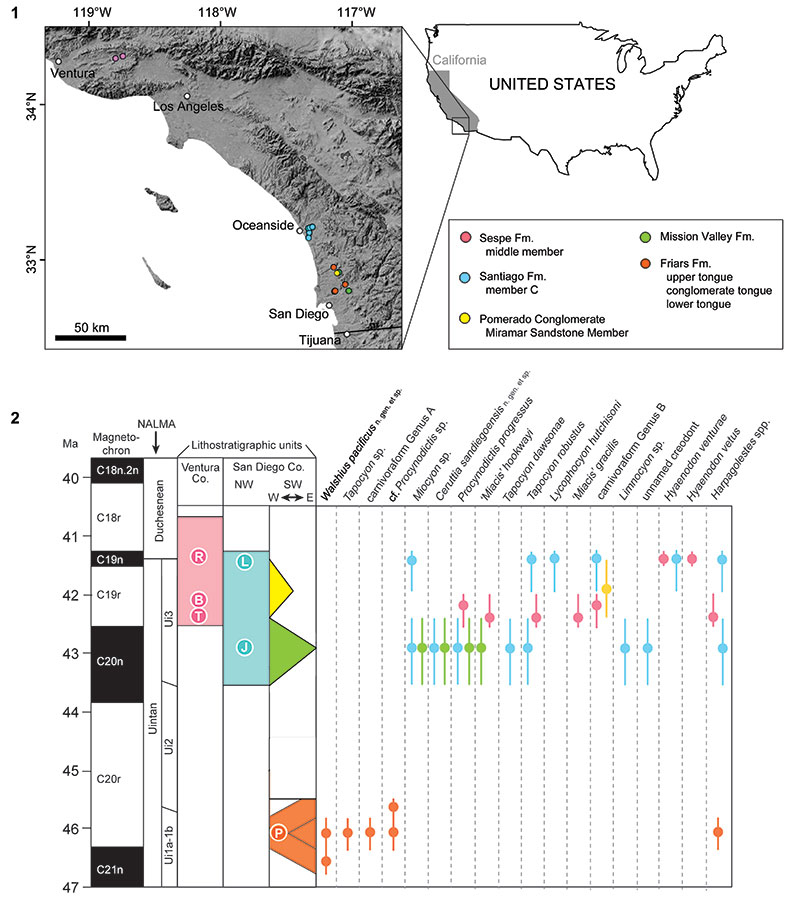
FIGURE 2. Dentition of Ceruttia sandiegoensis n. gen. et sp. Left premaxilla and maxilla of the holotype SDSNH 92504 in ventral view (1); left P4-M2 of SDSNH 92504 in occlusal view (2); left dentary fragment of SDSNH 92503 in labial view (3); left dentary fragment of SDSNH 42812 in labial (4), occlusal (5), and lingual (6) views; right dentary fragment (7) and right m2 (8) of SDSNH 42812 in occlusal view. Two white triangles in Figure 2.1 point to possible alveoli for M3. Black triangle in Figure 2.5 points to alveolus for m3. Same scale bar applies to Figure 2.1 and 2.4-2.7. Abbreviation: if, incisor foramen.
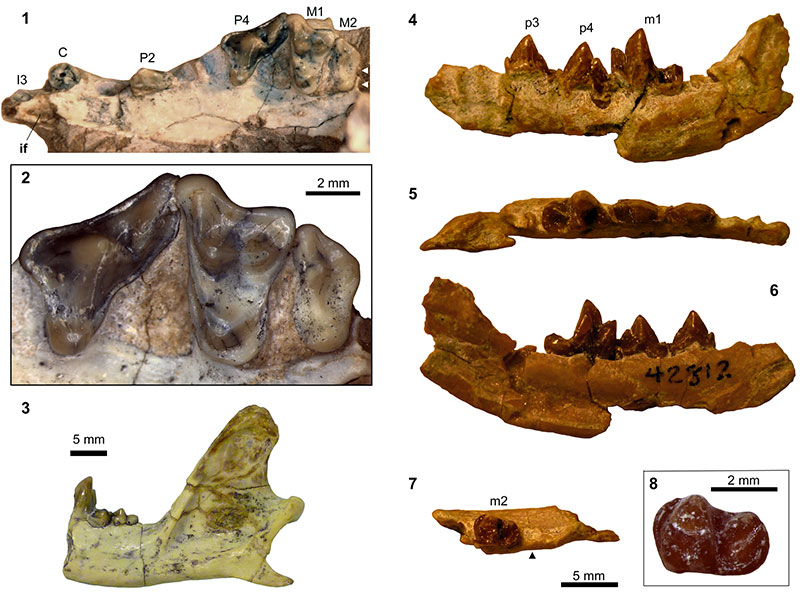
FIGURE 3. Left auditory region (SDSNH 92504) of Ceruttia sandiegoensis n. gen. et sp. Abbreviations: as, alisphenoid; er, epitympanic recess; fs, fossa for stapedius muscle; ftt, fossa for tensor tympani; fv, fenestra vestibuli; gf, glenoid fossa; Gf, Glaserian fissure; mp, mastoid process; pgf, postglenoid fossa; R, rugose area on petrosal promontorium; smf, suprameatal fossa; spa, sulcus for stapedius artery.

FIGURE 4. Dentition of Walshius pacificus n. gen. et sp. Right maxillary fragment of SDSNH 46197 in occlusal view (1); right maxillary fragment of SDSNH 62150 in lingual view (2, inverted);right dentary fragment of SDSNH 50599 (cf. W. pacificus) in labial (3), lingual (4), and occlusal (5) views.
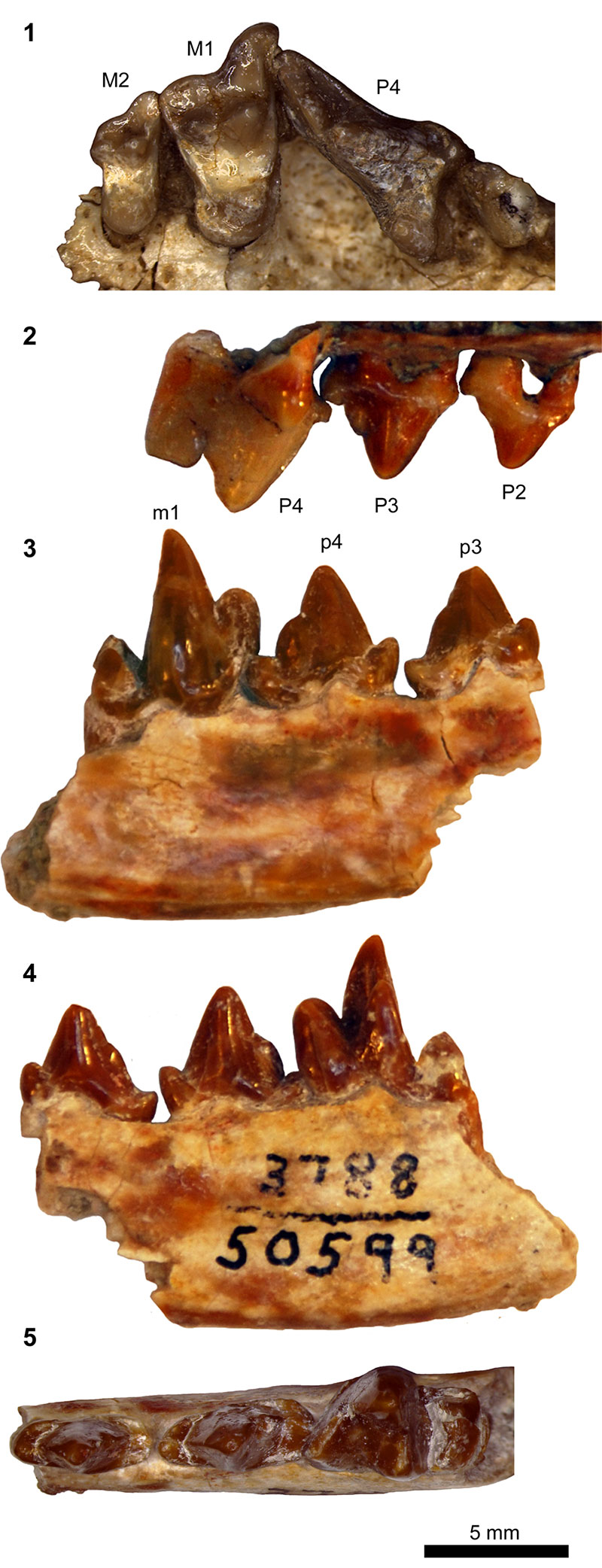
FIGURE 5. Dentition of Procynodictis and 'Miacis' gracilis. P. vulpiceps (AMNH 2514, Uinta Formation): left P3-M1 (1, 4); right dentary in labial (8) and occlusal (10) views. P. progressus (Santiago Formation): SDSNH 42813, left P4-M2 (3, 7); SDSNH 43744, right dentary in labial (9) and occlusal (11) views and left m2-m3 in occlusal view (17); SDSNH 43656, left m2 in occlusal view (16); SDSNH 42810, left dentary in labial view (18). Cf. 'M.' gracilis: LACM 40450, right P4-M1 from the Sespe Formation (2, 6; inverted). 'M.' gracilis: AMNH 104960 (cast of CM 12063) from the Uinta Formation (5). Cf. Procynodictis sp.: SDSNH 47389, left p4 in labial (12) and occlusal (14) views; SDSNH 55888, right m1 in lingual (13) and occlusal (15) views. Abbreviations: mf, mental foramina; pac, posterior accessory cuspid.

FIGURE 6. Dentition of specimens referred to 'Miacis' hookwayi. LACM 40463 (cf. 'Miacis' hookwayi), left maxillary fragment with P4-M2 (1) and right maxillary fragment with P3-M2 in occlusal (2) and lingual (3) views; LACM CIT 1656 (holotype), left dentary fragment with m1-m2 in occlusal view (4, inverted); SDSNH 84969, right m1-m2 in occlusal view (5).
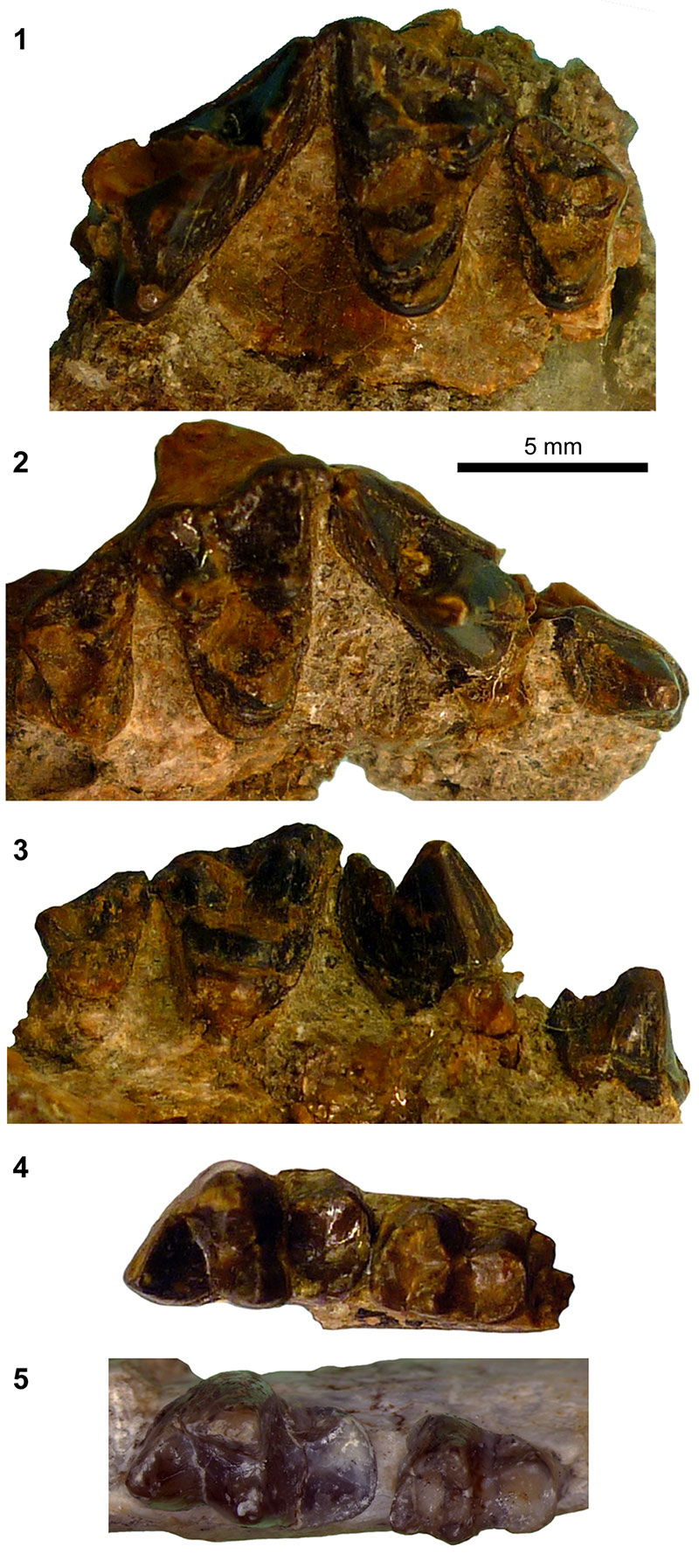
FIGURE 7. Undeterminate carnivoraform Genus A. Left dentary fragment with p4-m2 (UCMP 110072) in labial (1), lingual (2), and occlusal (3) views.

FIGURE 8. Undeterminate carnivoraform Genus B. SDSNH 56335, right middle-ear region (1), right P4-M2 (2) and cranium (3) in ventral view; UCMP 141385, left dentary in labial (4, inverted), occlusal (5), and lingual (6) views, left m1 in occlusal view (8), and left p3 in lingual view (9); UCMP 314191, left m2 in occlusal view (7). Black triangle in Figure 8.4 points to alveolus for m3. Scale bars for Figure 8.1 and 8.2 equal 5 mm. Figure 8.4-8.6 at the same scale. Abbreviations: bs, basisphenoid; end, entoconid; fc, fenestra cochlea; mf, mental foramina; pac, posterior accessory cuspid.
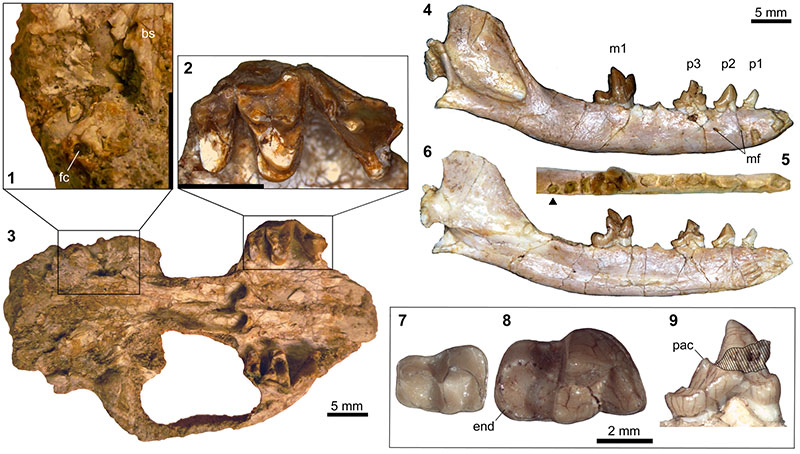
TABLE 1. Dental dimensions of Ceruttia sandiegoensis, n. gen. et sp. Measurements in millimeters. Where applicable, the arithmetic mean of measurements for the right and left teeth is reported. 1Measured at the base of crown.
|
SDSNH 92504 |
SDSNH 42812 |
SDSNH 46804 |
SDSNH 52968 |
SDSNH 54350 |
SDSNH 54945 |
SDSNH 42811 |
SDSNH 43657 |
SDSNH 92503 |
|
|
I3L1 |
2.02 |
||||||||
|
I3W1 |
1.15 |
||||||||
|
CL1 |
3.23 |
||||||||
|
CW1 |
2.54 |
||||||||
|
P2L |
3.85 |
||||||||
|
P2W |
1.69 |
||||||||
|
P4L |
6.57 |
||||||||
|
P4W |
4.78 |
||||||||
|
M1L |
4.41 |
4.38 |
4.62 |
4.85 |
|||||
|
M1W |
7.06 |
6.81 |
na |
7.24 |
|||||
|
M2L |
~2.5 |
2.18 |
2.67 |
2.14 |
|||||
|
M2W |
4.70 |
4.33 |
5 |
4.00 |
|||||
|
p3L |
4.37 |
||||||||
|
p3W |
1.99 |
||||||||
|
p4L |
5.31 |
||||||||
|
p4W |
2.26 |
||||||||
|
m1L |
6.23 |
5.97 |
na |
||||||
|
m1W |
3.68 |
na |
na |
||||||
|
m1 trigonid length |
3.92 |
na |
|||||||
|
m1 trigonid height |
~5.2 |
~6.2 |
|||||||
|
m2L |
3.61 |
3.42 |
3.62 |
||||||
|
m2W |
2.52 |
2.57 |
2.89 |
||||||
|
mandibular depth |
~6.9 |
8.44 |
TABLE 2. Dental dimensions of Walshius pacificus, n. gen et sp. Measurements in millimeters. SDSNH 50599 is tentatively referred to W. pacificus. Where applicable, the arithmetic mean of measurements for the right and left teeth is reported.
|
SDSNH 46197 |
SDSNH 62150 |
SDSNH 50599 |
|
|
P2L |
4.11 |
||
|
P2W |
1.70 |
||
|
P3L |
4.90 |
||
|
P3W |
2.59 |
||
|
P4L |
7.39 |
6.99 |
|
|
P4W |
4.47 |
4.88 |
|
|
M1L |
4.23 |
||
|
M1W |
7.70 |
||
|
M2L |
2.57 |
||
|
M2W |
4.93 |
||
|
P4-M2L |
12.86 |
||
|
p3L |
4.81 |
||
|
p3W |
2.02 |
||
|
p4L |
5.39 |
||
|
p4W |
2.46 |
||
|
m1L |
~6.2 |
||
|
m1W |
3.86 |
||
|
m1 trigonid length |
4.21 |
||
|
m1 trigonid height |
6.67 |
||
|
mandibular depth |
7.3 |
TABLE 3. Dental dimensions of the holotype of Procynodictis vulpiceps. Measurements in millimeters. Where applicable, the arithmetic mean of measurements for the right and left teeth is reported.
|
|
AMNH 2514 |
|
P1L |
3.58 |
|
P1W |
2.15 |
|
P2L |
5.97 |
|
P2W |
2.53 |
|
P3L |
7.28 |
|
P3W |
3.71 |
|
P4L |
9.57 |
|
P4W |
6.58 |
|
M1L |
5.36 |
|
M1W |
9.60 |
|
p3L |
6.65 |
|
p3W |
2.75 |
|
p4L |
7.96 |
|
p4W |
3.33 |
|
m1L |
9.29 |
|
m1W |
4.45 |
|
m2L |
4.87 |
|
m2W |
3.24 |
|
m3L |
2.15 |
|
m3W |
1.79 |
|
mandibular depth |
10.37 |
TABLE 4. Dental dimensions of Procynodictis progressus. Measurements in millimeters. Where applicable, the arithmetic mean of measurements for the right and left teeth is reported. 1Measurements not reported because of heavy dental wear or breakage. 2Estimated because of ventral breakage.
|
|
LACM CIT 1776 |
SDSNH 42813 |
SDSNH 47191 |
SDSNH 54416 |
SDSNH 42810 |
SDSNH 43744 |
SDSNH 47642 |
SDSNH 48100 |
SDSNH 54413 |
|
P4L |
10.13 |
8.60 |
8.79 |
||||||
|
P4W |
6.08 |
5.69 |
5.64 |
||||||
|
M1L |
6.38 |
6.05 |
|||||||
|
M1W |
10.70 |
10.00 |
|||||||
|
M2L |
3.01 |
||||||||
|
M2W |
6.33 |
||||||||
|
cL |
4.45 |
4.50 |
|||||||
|
cW |
3.11 |
3.42 |
|||||||
|
p1L |
2.83 |
||||||||
|
p1W |
1.48 |
||||||||
|
p2L |
5.15 |
5.43 |
4.56 |
5.20 |
|||||
|
p2W |
2.26 |
2.18 |
2.27 |
2.27 |
|||||
|
p3L |
6.54 |
5.84 |
6.73 |
6.07 |
|||||
|
p3W |
2.89 |
2.64 |
2.61 |
2.63 |
|||||
|
p4L |
7.12 |
7.08 |
8.07 |
6.74 |
6.71 |
||||
|
p4W |
3.27 |
2.92 |
3.14 |
2.98 |
2.78 |
||||
|
m1L |
9.04 |
~8.0 |
9.30 |
8.88 |
8.50 |
8.37 |
|||
|
m1W |
4.67 |
4.80 |
5.28 |
4.67 |
~4.6 |
4.97 |
|||
|
m1 protoconid height |
na1 |
8.35 |
|||||||
|
m1 metaconid height |
na1 |
5.78 |
|||||||
|
m2L |
~5.1 |
5.23 |
na1 |
4.71 |
4.68 |
||||
|
m2W |
3.24 |
3.51 |
na1 |
3.23 |
3.37 |
||||
|
m3L |
1.96 |
||||||||
|
m3W |
2.01 |
||||||||
|
mandibular depth |
~11.72 |
|
|
12.62 |
13.73 |
12.30 |
11.32 |
11.19 |
TABLE 5. Dental dimensions of specimens referred to 'Miacis' hookwayi. Measurements in millimeters. Where applicable, the arithmetic mean of measurements for the right and left teeth is reported.
|
|
LACM 40463 |
SDSNH 84969 |
|
P3L |
4.87 |
|
|
P3W |
2.63 |
|
|
P4L |
~7.3 |
|
|
P4W |
~4.4 |
|
|
M1L |
5.61 |
|
|
M1W |
7.86 |
|
|
M2L |
3.02 |
|
|
M2W |
5.20 |
|
|
p2L |
3.70 |
|
|
p2W |
1.77 |
|
|
m1L |
6.20 |
|
|
m1W |
4.02 |
|
|
m1 trigonid length |
4.10 |
|
|
m2L |
4.08 |
|
|
m2W |
3.14 |
|
|
mandibular depth |
7.80 |
TABLE 6. Dental dimensions of an undeterminate carnivoraform Genus A. Measurements in millimeters.
|
UCMP 110072 |
|
|
p4L |
5.50 |
|
p4W |
2.62 |
|
m1L |
6.36 |
|
m1W |
3.85 |
|
m1 trigonid length |
4.43 |
|
m1 trigonid height |
6.77 |
|
m2L |
3.74 |
|
m2W |
2.63 |
|
mandibular depth |
7.19 |
TABLE 7. Dental dimensions of an undeterminate carnivoraform Genus B. Measurements in millimeters. Where applicable, the arithmetic mean of measurements for the right and left teeth is reported.
|
|
SDSNH 56335 |
UCMP 141385 |
UCMP 314191 |
|
P4L |
~6.3 |
|
|
|
P4W |
~4.3 |
||
|
M1L |
4.15 |
||
|
M1W |
6.39 |
||
|
M2L |
2.51 |
||
|
M2W |
5.03 |
||
|
p1L |
2.02 |
||
|
p1W |
1.07 |
||
|
p2L |
3.11 |
||
|
p2W |
1.43 |
||
|
p3L |
4.22 |
||
|
p3W |
1.84 |
||
|
m1L |
5.50 |
||
|
m1W |
3.37 |
||
|
m1 trigonid length |
3.36 |
||
|
m1 trigonid height |
4.64 |
||
|
m2L |
3.34 |
||
|
m2W |
2.34 |
||
|
mandibular depth |
6.51 |
Susumu Tomiya Museum of Paleontology
Museum of Paleontology
Museum of Vertebrate Zoology
and Department of Integrative Biology
University of California
Berkeley, California 94720
USA
Susumu Tomiya is a vertebrate paleontologist at the University of California Museum of Paleontology and a lecturer in the Department of Integrative Biology at University of California, Berkeley. He holds degrees from the Johns Hopkins University (Earth and Planetary Sciences, B.A.) and University of California, Berkeley (Integrative Biology, Ph.D.). His research interests include diversity dynamics of fossil vertebrates, paleoecology and evolution of mammalian carnivores, and use of paleontological data to inform conservation biology.
New carnivoraforms (Mammalia) from the middle Eocene of California, USA, and comments on the taxonomic status of 'Miacis' gracilis
Plain Language Abstract
The extinct group of carnivorous mammals that gave rise to the living mammalian order Carnivora (which today includes dogs, cats, and their relatives) are known as basal carnivoraforms. According to previous molecular and paleontological studies, the evolutionary history of this group during the middle Eocene (49 to 37 million years ago) holds a key to illuminating the origin of carnivorans. Yet the diversity and distributions of carnivoraforms from this critical time period are poorly understood, partly because of limited taxonomic work since the early twentieth century. In an effort to remedy this situation, I examined in detail fossil carnivoraforms from the Uintan and the earliest Duchesnean North American Land Mammal Ages (ca. 47-41 million years ago) of southern California, which has yielded a remarkable diversity of middle-Eocene mammals. As the result, I describe in this paper two new genera as well as significant specimens of three known and two possibly-new taxa. In total, a minimum of 11 species of carnivoraforms are recognized in this regional fossil record. Of the nine species known from the late Uintan through the earliest Duchesnean ages (ca. 43-41 million years ago), at least six are apparently endemic to southern California. This high endemism is consistent with previous observations of increased faunal provinciality (i.e., different regions having distinct sets of species or genera) during this time period in North America, which may have reflected major geologic transformations taking place on the continent. The notably high number of carnivorous mammals corresponds to a high number (over 50 species in the late Uintan) of non-carnivorous mammals in the same region, suggesting a broad ecological link between mammalian predator and prey diversity in the deep geologic past.
Resumen en Español
Nuevos carnivoramorfos (Mammalia) del Eoceno medio de California, EE.UU., y comentarios sobre el estatus taxonómico de 'Miacis' gracilis
El Eoceno medio es un período clave para el estudio de la evolución temprana de los carnivoramorfos y el origen del grupo corona de los carnívoros. En este trabajo se describen dos nuevos géneros de carnivoramorfos del Uintiense (NALMA) de California meridional y se dan a conocer ejemplares no descritos hasta ahora de Procynodictis progressus, 'Miacis' gracilis, 'Miacis' hookwayi y dos taxones indeterminados para cubrir algunas de las lagunas en el conocimiento taxonómico. En concreto, los materiales fósiles aquí descritos apoyan la ubicación de P. vulpiceps and P. progressus en el mismo género aunque sugieren identidades distintas a nivel específico. Análogamente, 'M.' gracilis, que ha sido puesto en sinonimia con P. vulpiceps por algunos autores, se considera aquí una especie distinta de P. vulpiceps y P. progressus. Se reconocen un mínimo de once taxones carnivoramorfos en el Eoceno medio de California meridional, incluyendo nueve del Uintiense tardío al Duchesniense basal (entre hace unos 43 y 41 Ma). Entre estos últimos, al menos seis taxones son aparentemente endémicos de esta región, en consonancia con la alta provincialidad de las faunas norteamericanas de mamíferos durante esta época. Además de los carnivoramorfos, se han reconocido cuatro taxones de creodontos y un mesoniquio. La elevada riqueza taxonómica de mamíferos carnívoros de Eoceno medio en California meridional está relacionada con una alta diversidad de mamíferos no carnívoros, lo que está de acuerdo con la correlación entre diversidad de mamíferos depredadores y presas observada a distintas escalas espacio-temporales. Las distribuciones estratigráficas de los taxones del Uintiense tardío estudiados en este trabajo coinciden con las edades recientemente revisadas de las asociaciones de vertebrados de la Formación Sespe del condado de Ventura (California).
Palabras clave: Carnivoramorpha; Carnivoramorfos; Eoceno; California; nuevo género
Traducción: Miguel Company
Résumé en Français
Nouveaux carnivoraformes (Mammalia) de l'Eocène moyen de la Californie, Etats-Unis, et commentaires sur le statut taxonomique de 'Miacis' gracilis
L'Éocène moyen constitue une période importante pour comprendre le début de l'évolution des carnivoraformes et l'origine des carnivores. Je décris ici deux nouveaux genres de carnivoraformes provenant de l'âge des mammifères terrestres de l'Amérique du Nord de Uintan en Californie du Sud et signaler les spécimens jusque-là non décris de Procynodictis progressus, 'Miacis' gracilis, 'Miacis' hookwayi, et deux taxons indéterminés pour combler certaines lacunes dans les connaissances taxonomiques. Plus précisément, les matériaux fossiles décrits ici soutiennent la place de P. vulpiceps et P. progressus dans le même genre, mais suggèrent leurs identités distinctes au niveau de l'espèce. De même, 'M.' gracilis, qui a été placé en tant que synonyme de P. vulpiceps par certains auteurs, est considérée comme une espèce distincte de P. vulpiceps et P. progressus. Un minimum de 11 taxons carnivoraformes sont reconnus dans l'Eocène moyen de la Californie du sud, dont neuf provenant de la fin du Uintan jusqu'au début Duchesnean (env. 43-41 Ma). Parmi ces derniers, au moins six taxons sont apparemment endémique à cette région, se conformant ainsi au fort provincialisme des faunes de mammifères d'Amérique du Nord au cours de cette période. En plus des carnivoraformes, quatre taxons de créodontes et un mesonychid sont connus. La richesse taxonomique particulièrement élevé des mammifères carnivores de l'Eocène moyen de la Californie du Sud est associée à une forte diversité de mammifères non carnivores dans la même région; ceci est en accord avec les corrélations de la diversité entre prédateurs et proies mammifères qui ont déjà été observé à différentes échelles spatio-temporelles. Les distributions stratigraphiques des taxons de la fin de l'Uintan rapportés ici sont en accord avec les âges récemment révisées des assemblages de vertébrés de la Formation Sespe du comté de Ventura, en Californie, dans le sens parcimonieux.
Mots-clés: Carnivoramorpha; Carnivoraformes; Eocène; Californie; nouveau genre
Translator: Kenny Travouillon
Deutsche Zusammenfassung
Neue Carnivoraforme (Mammalia) aus dem mittlere Eozän von Kalifornien, USA und Bemerkungen zur taxonomischen Stellung von 'Miacis' gracilis
Das mittlere Eozän ist eine wichtige Epoche was das Verständnis der frühen Evolution der Carnivoraformen und den Ursprung der Kronengruppen – Carnivoren angeht. Es werden hier zwei neue Gattungen von Carnivoraformen des nordamerikanischen „Land Mammal Ages" (Uintium) aus Kalifornien beschrieben und es wird über bisher unbekanntes Material von Procynodictis progressus, 'Miacis' gracilis, 'Miacis' hookwayi und zwei unbestimmte Taxa berichtet, um einige der taxonomischen Lücken zu schließen. Speziell das hier beschriebene Fossilmaterial unterstützt die Zuordnung von P. vulpiceps und P. progressus in dieselbe Gattung, legt aber Unterschiede auf Artniveau nahe. Ebenso wird 'M.' gracilis, das von einigen Autoren mit P. vulpiceps synonymisiert wurde, als unterschiedliche Art angesehen und zwar sowohl zu P. vulpiceps als auch zu P. progressus. Ein Minimum an 11 carnivoraformen Taxa wurde im mittleren Eozän von Südkalifornien erkannt, von denen neun aus dem späten Uintium bis zum frühesten Duchesnium (vor ca. 43-41 Mio. Jahren) stammen. Von letzterem sind mindestens sechs Taxa offensichtlich endemisch in dieser Region und bestätigen so die hohe Provinzialität der nordamerikanischen Säugetierfaunen während dieser Zeit. Zusätzlich zu den Carnivoraformen sind vier Taxa von Creodonten und ein Mesonychide bekannt. Die bemerkenswert hohe taxonomische Fülle der mittel-eozänen fleischfressenden Säugetiere in Südkalifornien hängt mit der hohen Diversität an nicht- fleischfressenden Säugetieren von dort zusammen. Dieses Muster stimmt mit der Korrelation von Räuber und Beute Verhältnissen überein, welche in Bezug auf Säugetiere in verschiedenen raumzeitlichen Maßstäben beobachtet wurden. Die stratigraphischen Verteilungen der hier beschriebenen Taxa aus dem späten Uintium stimmen im Sinne der Parsimonie mit den kürzlich revidierten Altern der Wirbeltierassemblagen der Sespe Formation des Ventura County, Kalifornien, überein.
Schlüsselwörter: Carnivoramorpha; Carnivoraforme; Eozän; Kalifornien; neue Gattung
Translator: Eva Gebauer
Arabic
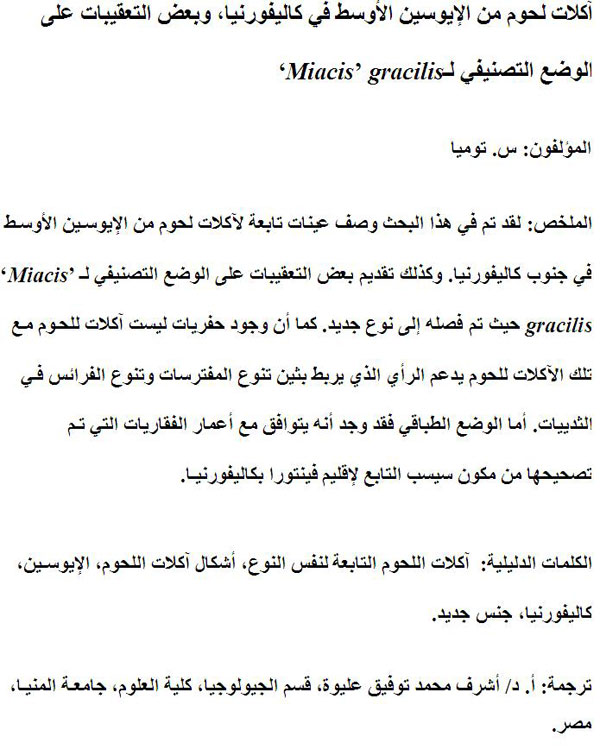
Translator: Ashraf M.T. Elewa
-
-
PE: An influential journal
 Palaeontologia Electronica among the most influential palaeontological journals
Palaeontologia Electronica among the most influential palaeontological journalsArticle number: 27.2.2E
July 2024





 A Review of Handbook of Paleoichthyology Volume 8a: Actinopterygii I, Palaeoniscimorpha, Stem Neopterygii, Chondrostei
A Review of Handbook of Paleoichthyology Volume 8a: Actinopterygii I, Palaeoniscimorpha, Stem Neopterygii, Chondrostei